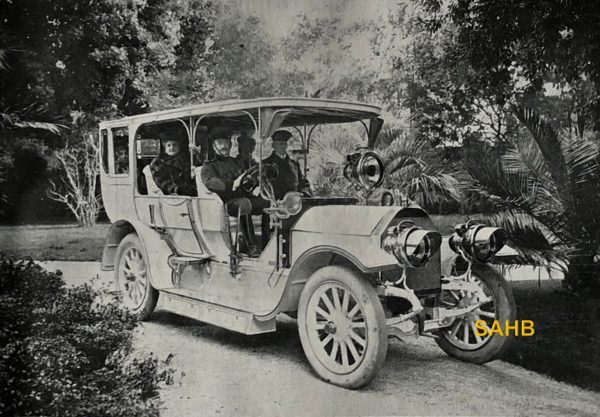
Of all the many touring and racing Itala cars produced by this distinguished Italian maker, this enormous 80 HP limousine is the most elusive. Indeed, the only apparent mention of it, apart from the caption to this 1907 image, was in Motor Sport in an article by Bill Boddy.
Itala started production in 1904 in Turin, founded by Matteo Ceirano and other partners. The Ceirano brothers, Giovanni Battista, Giovanni, Ernesto and Matteo, were variously responsible for at least seven Italian makes, including Ceirano; Welleyes (the technical basis of F.I.A.T.); Fratelli Ceirano; S.T.A.R.; SCAT; Itala and S.P.A.
In 1888, Giovanni Battista Ceirano started building Welleyes bicycles and in 1898, with his brother Matteo, co-founded Ceirano GB & C and started producing the Welleyes motor car. In July 1899 the plant and patents were sold to Giovanni Agnelli and produced as the first F.I.A.T.s. In 1904 Matteo Ceirano left Ceirano GB & C to create his own brand – Itala.
Three cars were offered in the first year, an 18 hp, a 24 hp and a 50 hp. They were firmly in the Mercedes mould, with honeycomb radiators, gate gearchange, low-tension magneto ignition and pressed-steel chassis frame. Their less conventional features were T-head engines and shaft (not side-chain) final drive.
In 1905 they started making racing cars with very large engines: a 14.8-litre 5-cylinder model won the Coppa Florio and Cagno, the chauffeur to HM Queen Margherita of Italy, won the 1906 Targa Florio at Brescia at 29.18 mph. In 1907 a 7,433 cc 35/45 hp model driven by Count Scipione Borghese won the Peking to Paris motor race by three weeks. Sporting success for this young company led to healthy growth.
Queen Margherita had a fleet of five Italas, including a 50/70 HP and the 80 HP six-cylinder in out Snapshot. This must have made an impression upon other members of royalty and aristocracy: five Grand Dukes, eight Princes, Bulgaria’s reigning monarch, and the Pope were all Itala owners. The cars were also popular in Britain: H.F. Locke King, who built the Brooklands Track, and his wife, had several cars of this make; one of them led the procession of cars round the Track at its opening in 1907. Other owners were the Earl of Caernarvon, Sir Thomas Lipton, the Thornton family (who possessed eight Italas), racing driver M. Bircham, actress Billie Burke, and nine members of the House of Lords. A British Itala service depot was set up within the 360-acre grounds of the Brooklands Motor Course; this became the site of Vickers-Armstrong’s aeroplane factory in 1915.
The caption to our Snapshot picture states that a similar car to the Queen of Italy’s 80 HP could be seen on the Itala stand at the 1907 Olympia Show; this enormous 13-litre machine was said to be offered in London for £1600.
The First World War brought to an end a remarkably successful period for Itala. During the war it built aero engines but reportedly lost money producing them. Production resumed after the armistice with models based on the pre-war cars, such as the Tipo 50 25/35 hp, but profitability was hard to find. From 1924 the company was run under receivership, and in 1929 it was bought by truck maker Officine Metallurgiche di Tortona. A few more cars were made up to 1935, and the remains of the company were sold to Fiat.
Photo courtesy of The Richard Roberts Archive.







Leave a Comment